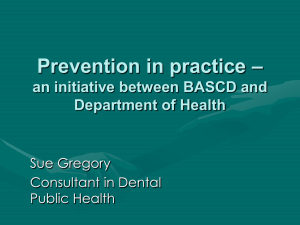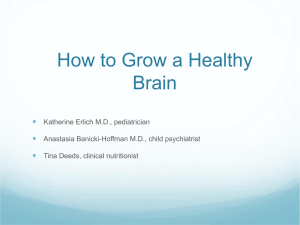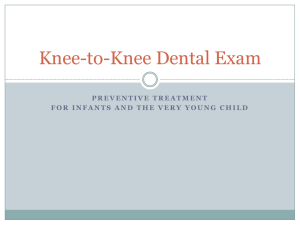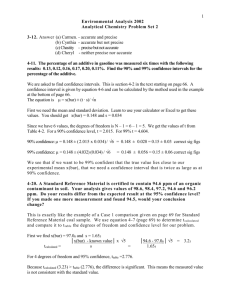Cover Letter 2 Edgar Oganessian, Romana Ivancakova, Erika
advertisement
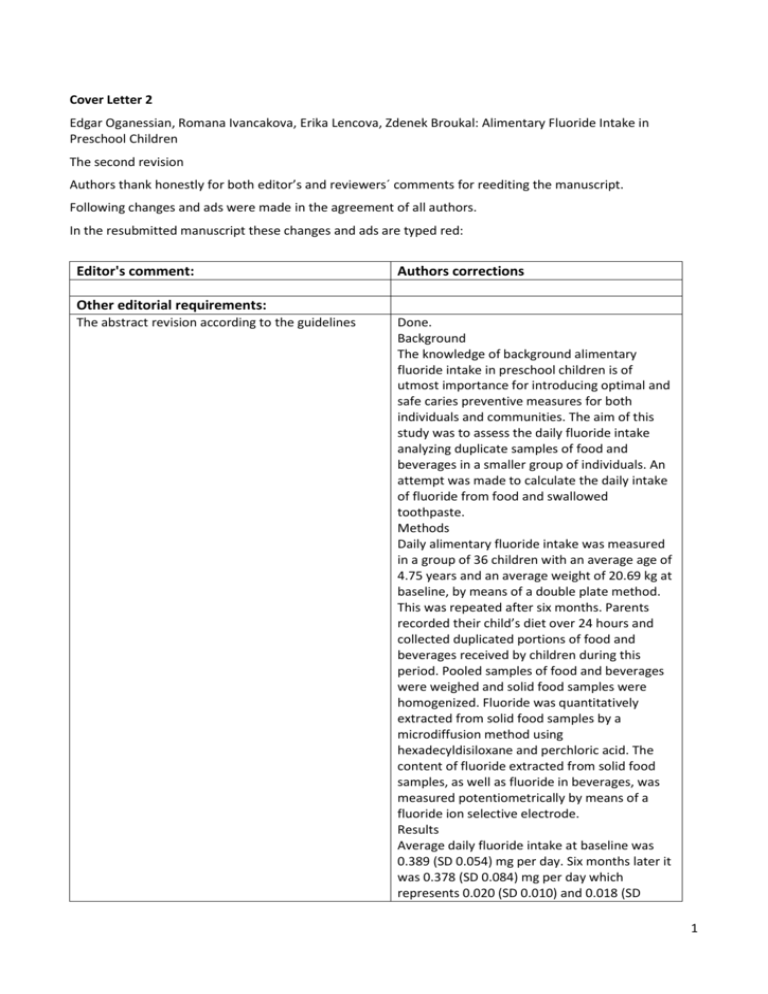
Cover Letter 2 Edgar Oganessian, Romana Ivancakova, Erika Lencova, Zdenek Broukal: Alimentary Fluoride Intake in Preschool Children The second revision Authors thank honestly for both editor’s and reviewers´ comments for reediting the manuscript. Following changes and ads were made in the agreement of all authors. In the resubmitted manuscript these changes and ads are typed red: Editor's comment: Authors corrections Other editorial requirements: The abstract revision according to the guidelines Done. Background The knowledge of background alimentary fluoride intake in preschool children is of utmost importance for introducing optimal and safe caries preventive measures for both individuals and communities. The aim of this study was to assess the daily fluoride intake analyzing duplicate samples of food and beverages in a smaller group of individuals. An attempt was made to calculate the daily intake of fluoride from food and swallowed toothpaste. Methods Daily alimentary fluoride intake was measured in a group of 36 children with an average age of 4.75 years and an average weight of 20.69 kg at baseline, by means of a double plate method. This was repeated after six months. Parents recorded their child’s diet over 24 hours and collected duplicated portions of food and beverages received by children during this period. Pooled samples of food and beverages were weighed and solid food samples were homogenized. Fluoride was quantitatively extracted from solid food samples by a microdiffusion method using hexadecyldisiloxane and perchloric acid. The content of fluoride extracted from solid food samples, as well as fluoride in beverages, was measured potentiometrically by means of a fluoride ion selective electrode. Results Average daily fluoride intake at baseline was 0.389 (SD 0.054) mg per day. Six months later it was 0.378 (SD 0.084) mg per day which represents 0.020 (SD 0.010) and 0.018 (SD 1 English copy edition of the paper 0.008) mg of fluoride respectively calculated per kg bw/day. When adding the values of unwanted fluoride intake from the toothpaste shown in the literature (0.17-1.21 mg per day) the estimate of the total daily intake of fluoride amounted to 0.554-1.594 mg/day and recalculated to the child’s body weight to 0.027-0.077 mg/kg bw/day. Conclusions In the children studied, observed daily fluoride intake reached the threshold for safe fluoride intake. When adding the potential fluoride intake from swallowed toothpaste, alimentary intake reached the optimum range for daily fluoride intake. These results showed that in preschool children, when trying to maximize the benefit of fluoride in caries prevention and to minimize its risk, caution should be exercised when giving advice on the fluoride containing components of child´s diet or prescribing fluoride supplements. English of revised manuscript was “polished” by Prof. Kenneth Eaton from UCL (UK). In case English is still poor I will contact Edanz. Reviewer's report (1): Juliano Pessan 1. Page 7, paragraph 1, line 1: Why was TISAB III used in proportion 1:1 (v:v)? This buffer is usually added at a 1:10 ratio. A reference is needed. 2. Page 7, paragraph 1, lines 6-7: The authors stated that quantitative extraction of fluoride was done "by a micro diffusion method using hexadecyldisiloxane and perchloric acid". The same information appears in the abstract. However, on the following paragraph (line 2), it appears that perchloric acid was saturated with "hexamethyldisiloxane". This needs to be clarified. Page 4, paragraph 1, line 5: Please insert "by which" after "The reason" Sorry for overlooking missing number zero (1:10). Corrected: In samples of liquid components TISAB III solution (1:10; v:v) was added for the pH adjustment. Fluoride content was measured directly by potentiometric method using fluoride ion selective electrodes described below. Corrected: Aliquot samples of solid and semi-solid food components with an added known volume of deionised water were also homogenized and processed by the quantitative extraction of fluoride by a micro diffusion method according to Taves (1978) [28] as modified by Van Winkle et al. (2005) [29]. A one ml sample of solid food was put in a 10 cm plastic dish followed by 2 ml of 5M perchloric acid saturated with hexadecyldisiloxane. Corrected: The reason why pre-school age children have been selected for the study of fluoride intake is that at this age an early secretory stage of 2 Page 4, paragraph 1, lines 7-10: The sentence is confusing. As a suggestion, the authors could consider: "Fluoride intake has usually been indirectly calculated, based on the records of daily diets and measured fluoride content in the most frequently consumed types of food and beverages [16, 17, 18, 31]." Page 5, paragraph 1, line 4: Quotation marks of "water for infants" are not necessary. Results (page 9, paragraph 1, lines 5-6): Please change "1 kg child's weight and 1 day" by "kg child's weight per day". Results (page 9, paragraph 4, line 1): Please replace "child´weight" by "child's weight". Page 10, paragraphs 2 and 3 should be combined into a single paragraph. Page 11, paragraph 2, line 2. Please insert "However," before "the estimate of alimentary..." Table 3 should be presented in the Results section of the manuscript. No caption for tables should appear in the Discussion. development of the permanent anterior teeth enamel takes place and is very sensitive to increased fluoride intake [2, 13]. Corrected: Fluoride intake has usually been calculated indirectly, based on the records of food and drinks consumed each day and to the known fluoride content ofn the most frequently consumed types of food and beverages [16, 17, 18, 31]. Corrected: Bottled water for infants is very popular, even in families of preschoolers, for its low content of nitrates, nitrites and sulphates. Corrected: The total fluoride intake of liquid and solid food components was then calculated per 1 kg child's weight per day. Corrected: The difference in the daily intake of fluoride calculated per child’s weight and day between baseline and after six months of study was not statistically significant (p<0.190). Corrected: The double plate approach therefore provides better evidence for alimentary fluoride intake than the “basket” approach. Even so, the results of this study should be interpreted with caution as they depended on how thoroughly and accurately the parents duplicated the food and drinks that their child actually received. Another limitation of this study is that the duplicate plate method was conducted for only 24 hours, both at baseline and after six months. Recent studies have suggested that it should be done at least for two consecutive days [11, 24, 27] in order to provide more accurate estimates. An attempt was made to reduce that limitation of the daily fluoride intake estimates by collecting food samples on days when their parents were off work and at home. Corrected: However the estimate of alimentary fluoride intake from toothpaste in preschool children must be treated with caution as it is highly variable among children [1, 19] due to the amount of toothpaste used, its flavour [15] and other factors. Added to the Results section: « Table 3 near here » Using the values of unwanted fluoride intake 3 from the toothpaste shown in the literature [6, 7, 9, 10, 16] (0.17-1.21 mg per day) it was possible to estimate how the similar intake from fluoride toothpaste in the summation with the results of this study contributed to the total daily intake and in the calculation of the intake of fluoride per 1 kg bw/day. The estimate of the total daily intake of fluoride amounted to 0.554-1.594 mg/day and recalculated to the child´s body weight to 0.027-0.077 mg/kg bw/day (Table 3). Changed in the Discussion section: When adding the values of unwanted fluoride intake from the toothpaste shown in the agematched children in the literature [6, 7, 9, 10, 16] (0.17-1.21 mg per day) it is possible to estimate that fluoride intake on average would reach the lower limit of the safe range (0.05 to 0.07 mg/kg bw/day). This range is supported by previous studies [16, 17, 18]. However, for some children this range could be exceeded. Reviewer's report (2): Michael McGrady ... to expand the discussion to include the effect of stomach contents, pH and presence of ions such as calcium on the absorption of fluoride systemically as this has a major impact upon the relative risk of developing fluorosis. ... a discussion relating to the risk benefit of fluoride and caries in Discussion and Conclusion sections Added to the Discussion section: The dynamics of fluoride absorption, whether coming from food or swallowed toothpaste depends on the stomach contents, pH and some ions such as calcium and can have a major impact upon the relative risk of developing fluorosis. The enamel maturation can be endangered both by the long-lasting overintake of fluoride or, to some extent, by the steep peaks of plasma fluoride due to its quick absorption from empty stomach [2, 22]. Added to the Discussion section: Irrespective of the generally accepted major impact of topical fluoride in caries prevention its systemic intake in preschool children can contribute both to its benefit and to the risk of developing fluorosis. One of the main issues of dental public health is to minimize the risk of fluoride overdose by the fluoride and diet counselling both in individual and community levels. Added to the Conclusions section: These results showed that in preschool children, when trying to maximize the benefit of fluoride in caries prevention and to minimize its risk, caution should be exercised when giving advice on the fluoride containing components of child´s diet or prescribing fluoride supplements. 4 September 8, 2011 Zdenek Broukal (corresponding author) 5
